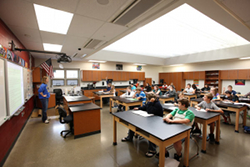
by Shane Henson — December 16, 2011—Schools across the country are playing an important role in promoting sustainability by creating sustainable learning environments while educating students, staff, and the public on the necessity of green initiatives. The U.S. Green Building Council’s (USGBC) Center for Green Schools recently recognized many school administrators and government leaders through the Best of Green Schools 2011 list.
According to officials within the Center for Green Schools, recipient schools and regions from across the nation—from K-12 to higher education—were recognized for a variety of sustainable, cost-cutting measures, including energy conservation, record numbers of buildings certified to the USGBC’s Leadership in Energy and Environmental Design (LEED) program, and collaborative platforms and policies to green U.S. school infrastructure.
The 2011 recipients are:
- Moment for the Movement: U.S. Department of Education, Green Ribbon Schools—Green Ribbon Schools is the first comprehensive and coordinated federal initiative to focus on the intersection of environment, health and education.
- Region: Sacramento area—Mayor Kevin Johnson has led the charge to bring together mayors and superintendents from across the Northern California region to create a $100 million revolving loan fund for green school retrofits.
- State: Ohio—With 315 LEED registered and certified projects, including 19 schools registered in 2011, Ohio leads the nation with more green school projects underway than any other state.
- City: Philadelphia—The School District of Philadelphia made significant steps in 2011 toward the greening of the city’s 291 public schools.
- School: Lake Mills Middle School in Lake Mills, Wisconsin—In March 2011, Lake Mills Middle School became the first public school in the nation to achieve LEED Platinum certification.
- Higher Ed Innovator: University of Texas at Dallas—The University’s new LEED Platinum Student Services Building, which was the recipient of this year’s Innovation in Green Building Award, was designed to improve departmental efficiency and interaction, includes terra-cotta shades on the building’s exterior to provide a unique energy-efficient shading strategy and was built $1.1 million under budget.
- Collaborators: Kentucky Reps. Jim DeCesare (R) and Mary Lou Marzian (D)—Together, they’ve worked with their colleagues in the Kentucky General Assembly to unanimously adopt resolutions in support of green schools, and have encouraged other states to work across party lines on similar efforts.
- Convener: Boston—In September 2011, Mayor Menino hosted the Research Summit on Childhood Health and School Buildings, which brought together a team of interdisciplinary researchers to explore the connection between school facilities and student health.
- Policy makers: District of Columbia City Council—In May 2010, the Washington, D.C. council unanimously passed the Healthy Schools Act of 2010, building upon the District’s existing LEED Silver requirement and encouraging schools to achieve LEED Gold certification.
- K-12 Innovation: Public-Private partnership in Illinois—A report outlining a plan to green all K-12 schools in Illinois was released in March 2011 as a result of a public-private partnership commissioned by the Illinois’ General Assembly’s October 2009 adoption of House Joint Resolution 45.
- Region: Sacramento area—Mayor Kevin Johnson has led the charge to bring together mayors and superintendents from across the Northern California region to create a $100 million revolving loan fund for green school retrofits.




